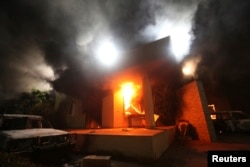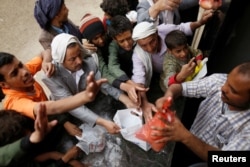Revolutions have a way of going in unexpected directions, the 19th century political philosopher Friedrich Engels once noted.
The morning after, he said, people realize “the revolution they made was nothing like the one they had wanted to make.”
His words seem especially on target for the protests that became known as the Arab Spring.
Seven years ago, a wave of protests swept across the Middle East and North Africa. The unrest fueled revolutions and leadership changes in a number of countries. Yet none have met the hopes of the revolutionaries. Many of the demonstrators were average citizens simply seeking change and an escape from corruption.
Nor has the Arab spring met the expectations of Western observers and those who expressed support for the protests.
The Arab spring once was celebrated in Western capitals and motivated many young Arabs. Yet within months, the unrest turned ugly and regrettable. It wrecked the hopes of those who believed that overthrowing dictators and holding elections would lead to improvements and end political repression.
Attack in Benghazi
For the West, the first real event of concern was when jihadist militants attacked the United States diplomatic office and a nearby intelligence center in Benghazi, Libya. The attack resulted in the deaths of four Americans. One of those killed, the U.S. ambassador to Libya Christopher Stevens, was a supporter of the Arab Spring.
That attack showed how unruly the Middle East had become and how easily jihadists could create unrest.
Many Arabs did not like what they were seeing. They had hoped the Arab Spring would lead to greater personal freedoms and improved living conditions.
Egypt
In Egypt, an authoritarian Islamist government angered both progressives and supporters of former ruler Hosni Mubarak. The army ousted the country’s Islamist president, replacing him with General Abdel Fattah El-Sissi, who acted a lot like Mubarak.
El-Sissi ordered the arrest of a former army general who planned to compete against him in Egypt’s next presidential election. The former general is the fourth possible candidate to be detained in what appears to be a state campaign to drive would-be opponents from the race.
Egypt watchers say El-Sissi and his allies appear firm about wanting a trouble-free vote. Activists say such an election would be an insult to the 2011 demonstrations.
Unrest in Libya, Yemen, and Syria
Seven years have passed since Libyans ousted Colonel Moammar Gadhafi as the country’s leader. Since then, a series of prime ministers have failed in their efforts to establish order and reduce the power of ideological and town-based militias. Fighters allied with the Islamic State group have seized territory along Libya’s coast. They have executed their enemies and Christians.
Yemen’s political unrest has led to civil war, starvation and empowered extremists. Opposing sides have appealed to outside powers, such as Saudi Arabia and Iran, for help.
In Syria, the government’s repression of non-violent reform protests gave way to an armed rebellion. The unrest led to the intervention of foreign powers, including Russia, the United States, Iran, Saudi Arabia, Turkey and Qatar. The Syrian conflict was quickly distorted by the rise of the Islamic State group and clashes between Islamists and moderates. With hundreds of thousands of people dead, there is still no end in sight to the fighting.
With the collapse of governments and the break-up of Arab states, religious leaders and extremists filled the void. Progressives and moderates were unprepared to deal with the situation and Western countries lost hope, observers say.
What did go wrong?
John Bradley wrote the book After the Arab Spring: How Islamists Hijacked the Middle East Revolts. He argued early on the West and progressive Arabs were guilty of wishful thinking and too quick to praise the roots of the Arab Spring.
Others believed the Arab Spring could have ended differently. Matthew Partridge wrote a critique of Bradley’s book. He noted “America and Europe need to lead from the front – not from behind.”
Another observer, Bill Lawrence, has said the West was as much an onlooker as a player in the Arab Spring. Lawrence once worked at the International Crisis Group, a New York- and Brussels-based research organization. He argues that “a big mix of forces came together in the region to express rage over hopeless economics, corruption and abusive government.”
Population studies of the Middle East suggest that one cause of the unrest, jobless young men, will long remain. All the Arab spring countries share at least two things. They have young populations and they are unable to create jobs.
The birthplace of the Arab Spring, Tunisia, has been able to make a relatively peaceful move from authoritarian rule to a working democracy.
But this month and in December, new economic reform measures, with higher prices for foods fuel and energy, led to street protests. Police and protesters clashed. Some of the demonstrators came from a youth movement called Fesh Nestannew, which means “What are we waiting for?”.
Like the 2011 protesters, they are demanding better lives.
I'm Jonathan Evans.
Jamie Dettmer wrote this story for VOANews.com. George Grow adapted his report for Learning English. Hai Do was the editor.
_________________________________________________________________
Words in This Story
philosopher – n. a student of philosophy (ideas about knowledge, truth and the meaning of life)
sweep – v. to move in a wide curve; to touch in passing with a fast, continuous movement
ugly – adj. unpleasant or morally offensive
Jihadist – adj. a Muslim who supports jihad (a holy war in defense of Islam)
distort – v. to change the appearance of something in a way that others find displeasing
void – n. an opening or empty space
rage – n. violent, uncontrolled anger
authoritarian – adj. requiring people to obey rules or those making the rules
We want to hear from you. Write to us in the Comments Section.













